- Faculty News
- Student News
- Lab News
- Publications
- Meetings and Presentations
- Outreach
- Grants
- Announcements
- About This Newsletter
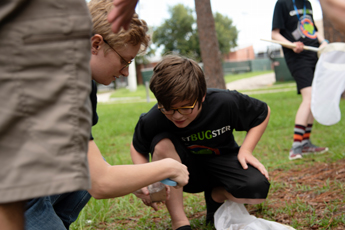
ABOVE: Katie Carroll assists a camper in pitfall collection during Bug Camp on June 25th.
A note from the Chair…
My contribution to this month’s newsletter is bittersweet as it will be my last as department chair. As most of you already know, I will be moving to Penn State University as Associate Dean for Research and Graduate Education in the College of Agricultural Sciences. The decision was not an easy one as I have grown very fond of this department and its people.
It has been my pleasure to have worked with such a dedicated, enthusiastic, and fun group of people. I have received compliments from so many of you, most of which I don’t really deserve but am grateful to hear. I cannot imagine a better opportunity to lead a department, and my decision to leave UF is not driven by a desire to move, but a lifelong ambition to be close to my family and the obligations that I have to our small farm. As I’ve said to many of you, I spent the first 5 years of my adult life trying to get as far away as possible and the next 30 trying to get back. It has taken a while, but I look forward to being close to my family and the land that has been in our family for four generations.
Florida is also home to me. I began my academic career as a graduate student of this department in 1981 and I view UF as the launching point for both my professional and personal life. My wife Sidney was born and raised here in Gainesville, so I know we will always remain close to the family and friends that we have here in Florida, especially those in the Department of Entomology and Nematology. Without the mentoring and experience that UF has provided to me both as a student and department chair, I am not sure where I would have ended up and will always be indebted to this institution and its people. I also know that we will make repeated trips back to Florida and look forward to catching up with each of you upon our return. Central Pennsylvania is also a nice place to visit if you get the chance!
As I look back on the last 6 years, I would like to think that we’ve built upon the strong foundation that was laid by Dr. John Capinera over the 28 years that preceded my arrival. While we have grown and changed considerably with the hiring of approximately 30 new faculty around the state and here in Gainesville, none of it would have been possible without John’s previous leadership. Our undergraduate program and distance education programs have grown considerably, our graduate program is the best and biggest, and our research and Extension programs continue to generate novel information to better understand the amazing organisms we study and to provide information that addresses the critical needs of our stakeholders. Our staff is second to none in their commitment to serving the needs of our faculty and students, and it has been a privilege to have worked with each of you. The combination of the best and the brightest scientists and educators with outstanding students will ensure the success of our disciplines for generations to come. I can only see continued growth and prosperity for this department and know that Dr. Heather McAuslane is positioned to provide outstanding leadership after my departure. I hope that my role in the department is viewed as one that has promoted a safe and welcoming work environment with a statewide presence where people enjoy their work and have opportunity to learn, to discover and to contribute to a “Greater Gator Good.” With my sincere best wishes and thanks to all,
-Blair D. Siegfried, Professor and Department Chair

The Taylor lab is on NETFLIX! The Taylor lab's work was recently featured in David Attenborough's new series Life in Color. The series explores how and why animals use color throughout the natural world. In episode 3 ("Chasing Color"), David narrates while Lisa puts makeup on spiders and describes some of the lab's recent experiments and findings. The series is currently airing on Netflix.


One year of DEI committee...
It has been one year since our departmental Diversity, Equity and Inclusion committee was formed in the aftermath of the horrific murder of George Floyd. Although this case ended with a criminal conviction and offers some justice for the Floyd family and others, the work of justice, equity, and inclusion in society, and in this department, is a marathon, not a sprint. With that disclaimer, I want to lift up the tireless efforts of members of the Entomology & Nematology DEI committee this last year and highlight some their achievements. We have a website, thanks to Suzy and Kay, that will soon be populated with even more educational material and events to increase your awareness of DEI issues. We conducted a climate survey that helped us understand issues that were not widely known in the department. We are also starting to plan a wider variety of social activities, and we are diversifying the seminar speaker lineup. We are tracking the recent and current racial/ethnic demographics of our student, staff, and faculty body and are following best practices and new practices to increase diversity. Finally, we have a strategic plan and will be held accountable for our actions on it when we meet with IFAS Vice President Scott Angle and other departments in November or December. It will take all members of the department to realize the goals of the strategic plan, so please look at the plan and see where you can make a difference. Thank you to members who rotated off the committee this year (Purity Muthomi, Christine Miller, Chelsea Smartt, and Lindsay Campbell). Many thanks to continuing members Oscar Liburd, Sarah Anderson, James Brown, Faith Oi, Hannah Talton, Ginny Greenway, and Suzy Rodriguez, and special thanks to Adam Dale and Decyo McDuffie who will take on the co-chair responsibilities this fall. Finally, thanks to the new members joining us this fall: Kelly Carruthers, Peter DiGennaro, Robert Grosdidier, Yoosook Lee, Cameryn Lein, and Lukasz Stelinski. As always, everyone is encouraged to attend the DEI committee’s open meetings to provide your thoughts, perspective, and energy to the conversation and activities/events so that we can make some real strides in increasing diversity in the department and enhancing our climate to be more inclusive and affirming.
- Heather McAuslane (DEI committee chair)


Research Experience for Undergraduate
With funding from the National Science Foundation, Dr. Christine W. Miller and Dr. Michael Forthman are supporting three Research Experience for Undergraduate (REU) students this summer. The students are working onsite in Sacramento at the California State Collection of Arthropods, part of the California Department of Food and Agriculture (CDFA). All three students are working on advancing knowledge of resource allocation decisions that insects make during development, research that is applicable to a variety of entomological subdisciplines. Dr. Forthman, a former postdoctoral associate in our department, is now an insect systematist at CDFA. The research is being carried out on members of the leaf-footed bug family, Hemiptera: Coreidae. Katie Adler, Anna Schill, and Alex M. Stolberg are students from multiple academic institutions, Kalamazoo College, Ohio Wesleyan University, and the University of California – Berkeley. From this early experience in their science education, the students are learning about the amazing world of insects as well as the value of collaboration across institutions and with scientists with different specializations.
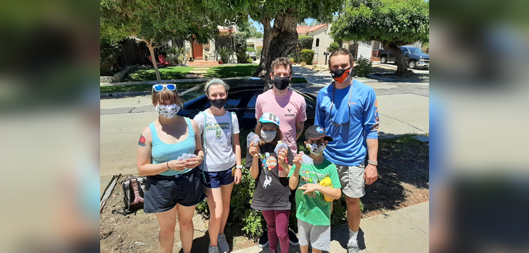

Dr. Erin Powell (recent postdoc in the Taylor lab) just started a new position at DPI as a Biological Scientist IV where she will be handling the Coccoidea and Aleyrodidae (scales, mealybugs, and whiteflies). We are sad to say goodbye, but very happy for her and wish her congratulations on this new adventure. And, of course, we are thrilled to keep her in Gainesville!
Need to name that bug? A host of experts are available to help Floridians identify any insect or related arthropod. If a mystery creature has six or more legs, the UF Insect ID Lab is the place to call.
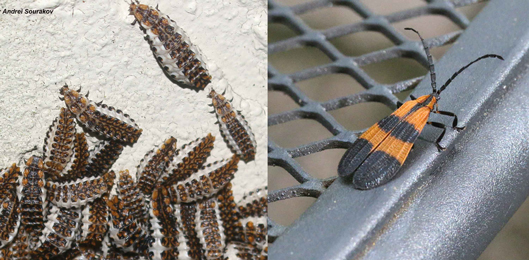
Need insect images? The Entomology and Nematology Department has a large collection of images of insects and insect relatives for use in your extension, teaching, and research work. This collection is available for use by UF IFAS personnel on the main campus, at the Research and Education Centers, and at the county extension offices around the state. A set of the best images (over 14,000 images) are accessible online from your own computer! You can go to this direct link, http://entnemdept.ifas.ufl.edu/imgs or you can go through our departmental homepage by choosing the “About Us” tab and then clicking on “Resources”. Since the pictures are copyrighted material and intended for official UF use only, you will be asked to log onto the website using your Gatorlink credentials. Please check it out, and if you have any questions or comments about the image collection, let Lyle Buss know at LJBuss@ufl.edu

Think it might be a nematode problem? The Nematode Assay Laboratory serves Florida and other states by providing nematode assays and expert advice regarding nematode management.
For more information on the Nematode Assay Laboratory, please contact the lab manager Dr. Billy Crow.
Burkett-Cadena ND, Blosser EM, Loggins A.A. 2021. Invasive Burmese pythons alter host use and virus infection in the vector of a zoonotic virus. Commun Biol 4, 804. https://doi.org/10.1038/s42003-021-02347-z
de Sá Leitão DAH, Pedrosa EMR, Dickson DW, Brito JA, Santos Oliveria AK, Rolim MM. 2020. Upward migration of second-stage juveniles of Meloidogyne floridensis and M. incognita under different plant stimuli. Eur J Plant Pathol. https://doi.org/10.1007/s10658-021-02322-8
dos Santos Oliveira AK, Pedrosa EMR, Dickson DW, Vau SJSSO, de Sá LeitãoDAH, Silva EFF. 2021. Migration and penetration of Meloidogyne enterolobii and M. incognita in soil columns with tomato and marigold. Eur J Plant Pathol 158:591–598. https://doi.org/10.1007/s10658-019-01889-7
Hahn PG, Keefover-Ring K, Nguyen LMN, Maron JL. 2021. Intraspecific correlations between growth and defence vary with resource availability and differ within and among populations. British Ecological Society. https://doi.org/10.1111/1365-2435.13878.
Zhang Y, Cai T, Ren Z, Liu Y, Yuan M, Cai Y, Yu C, Shu R, He S, Li J, Wong ACN, Wan H. 2021. Decline in symbiont-dependent host detoxification metabolism contributes to increased insecticide susceptibility of insects under high temperature. ISME J. https://doi.org/10.1038/s41396-021-01046-1

New on Featured Creatures:
Sophia or transvena parasitic wasp, Encarsia sophia Girault and Dodd (Insecta: Hymenoptera: Aphelinidae) written by Erich N. Schoeller, Vivek Kumar, and Lance S. Osborne.Croton scale, Phalacrococcus howertoni Hodges & Hodgson (Insecta: Hemiptera: Coccidae) written by Eleanor F. Phillips, Jennifer L. Gillett-Kaufman.
Eastern cranberry bee, Melitta americana Smith (Insecta: Hymenoptera: Melittidae: Melitta) written by Lidia Komondy and Cameron Jack.
Do you have a favorite creature? Learn how to make it into a Featured Creatures!
Leo Ohyama, PhD Canidate in the Lucky Lab, was selected as a plenary speaker at the British Ecological Society's Macroecology meeting on July 6th. His talk was titled "Omnivory mediates the latitudinal trend of ant size". This work is being co-lead by Leo and Dr. Douglas Booher from the Yale Center for Biodiversity and Global Change.
Entomology Education and Outreach News
return to topDon’t forget the Entomology and Nematology Education and Outreach Program is available and will accommodate both virtual and approved in-person presentations!
Recent Outreach events:
Throughout the month there were many virtual presentations to youth of Alachua County Schools, the arthropod zoo was loaned out for some 4-H’ers, and visitors came in to the department to see the department and critters.
June 3rd Orange County Public Schools Agriculture Career Experience: 29 students visited the Entomology & Nematology Department and the Honey Bee Research and Extension Lab for a tour, had a hands on experience with the arthropod petting zoo, and viewed a live bee hive demonstration. Dr. Rebecca Baldwin led the tours of the Entomology Dept. with Sarah Tafel assisting. Jennifer Standley led the tours at the HBREL with Brynn Johnson, and Chris Oster assisting.
June 8th Villages Entomology Presentation with Dr. Carl Barfield: Dr. Rebecca Baldwin presented at the Villages Residence with Jennifer Standley assisting. The arthropod petting zoo was a hit among the residents.
Bug Camp (Entomology Field Camp) June 21-25th: The in person “Ghost-BUG-sters” camp was a week-long event for 24 youth between the ages of 10-18. The campers learned all sorts of cool things featuring “Scientists of the Day”. Those brilliant scientists were: James Pinkney (pitfall traps and intro quiz), James Brown (learning about the NATL and collecting), Emilie Demard (“mitey mites”), Nagarajan Rajagopal and Sarah Tafel (beeswax lip balm/cochineal dye), Sarah Anderson & Jennifer Standley (bee biology), Jennifer Standley and Brynn Johnson (Honey Bee Lab tour and live demonstration of a honey bee colony), Caitlin Taylor (fly food choice experiment), Dr. Wade Davidson and Dr. Crow (nematology), Clayton Bania (greenhouses tour with a fun plant give-away), Ashley Morris (who’s most attractive with mosquitoes), Yasmin Tavares and Amy Bauer (mosquito trapping and ID), Clancy Short (cockroach and ant venom demonstration), Katie Carroll (pitfall collection ID and post-test). We also couldn’t have done it without all the fabulously helpful volunteers: Sarah Tafel, Christian Fernandez, Cameryn Lein, Jordyn Ranfone, Brett LaBella, Ellie Gulkis, Cameron Zuck, Jordyn Diaz, Mike Weir, Richard Murphey, Kaylin Kleckner, and Chris Oster.
June 29th Filming for TV-20 at the Florida Museum. Dr. Rebecca Baldwin gave some awesome recorded clips featuring entomology and the arthropod petting zoo to be viewed on TV-20!

Entomology on the Go -
What’s better than a live show and tell of some really cool arthropods?! Our live petting zoo consists of: tarantulas, scorpions, vinegaroons, bess beetles, Madagascar hissing cockroaches, and native insects, when in season. With a short training program, they are available for you to check out should you be leading an outreach event, even if it is virtual. The critters are always popular with both youth and adults and are used as a tool to expose the public to STEM disciplines. We have large wood and Plexiglas cages for viewing our native orb weaving spiders. There is one travel cage and one larger static cage. We also have activity kits and lesson plans that are available as well. Please be sure to contact us and review the protocol on transportation and handling of the animals. If you lead an outreach event, be sure to fill out a documentation form so your event can be included in the newsletter and we can log all outreach events. Also, note that volunteering to assist with outreach events will count as departmental service for ENSO travel grants. (Please note that some venues require background checks or additional screening.)
If you have any questions or would like to volunteer, please email us.
Cheers! - Jennifer Standley, Outreach Coordinator.

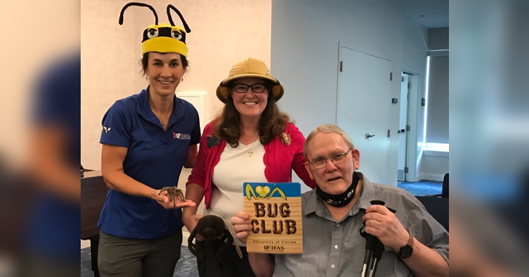
ABOVE: Left to right: Jennifer Standley, Dr. Rebecca Baldwin, and Dr. Carl Barfield at the Villages for a presentation to residents on the wonderful world of Entomology on June 8th.

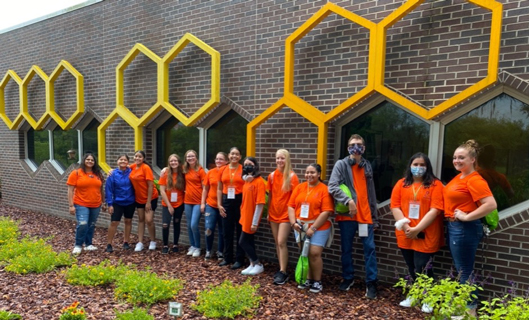
ABOVE: 29 Orange County Public Schools Agriculture Career Experience students visited the Entomology and Nematology Department and the Honey Bee Research and Extension Lab on June 3rd. (Photo credit: Jennifer Standley)


ABOVE: 24 “Ghost-BUG-sters” campers and counselors having fun on the last day of Bug Camp.


ABOVE: Dr. Rebecca Baldwin showing Sigrid Noah (“Ghost-BUG-Ster” Bug Camper) some interesting things under the microscope.
Getting social!
Use #UFBugs so our department can find and share your social posts easily!
The ESA annual meeting will take place in Denver, Colorado October 31st to November 3rd. Registration now OPEN!
Want to stay up to date? Check out our website home page for a link to our Google calendar.
Suzy Rodriguez is the newsletter editor and does the HTML coding. Newsletters usually are published around mid-month. Submit items for an issue by the seventh of the month.
We like to share news when it happens using our social media outlets: Twitter, Facebook and YouTube. Follow us on these sites for daily updates! When you send news, we will post it on one or more of these sites and again in the monthly newsletter. Please be sure you have permission from people in photographs you submit for publication.
UF-Bugnews-L listserv subscribers receive notices when issues are posted. Our home page has instructions for subscribing and unsubscribing.
Special thanks to James Brown and Nancy Sanders for reviewing the newsletter for errors, and to Jane Medley and Don Wasik for webpage build and design.
Give Back
Want to support the UF Entomology & Nematology Department? Consider making an online gift today! Questions can be directed to Cody Helmer at (352) 392-1975 or chelmer@ufl.edu.